EUROPE Contemporary 2017EUROPE Contemporary 2017
April 19, 2018
2017年9月、本学版画研究室の学生たちがヨーロッパの主要なアートイベントを見学する研修旅行に参加しました。ドイツのカッセルの行われたドクメンタ、イタリアのヴェネツィアビエンナーレ、スロベニアのリュブリャナ国際版画ビエンナーレを見学し、非常に貴重な経験を得ることができました。また同時期には、10年に一度のミュンスター彫刻プロジェクトも開催されており、本研修の予定にはなかったものの、学生たちは個別に足を運んでいました。
最初はカッセルのドキュメンタを訪れました。100日間続いたイベントの最終週に当たるタイミングで到着したため、批評家や芸術家の反応やキュレーションのコンセプトなどについて、このイベントに対して事前に研究しておくことができました。また、ドクメンタの教育プロジェクトの内で行われた、カッセル芸術大学、ベルン芸術大学、アールト大学による共同イベントKnowledge gathering – Gathering knowledgeにも参加することができました。
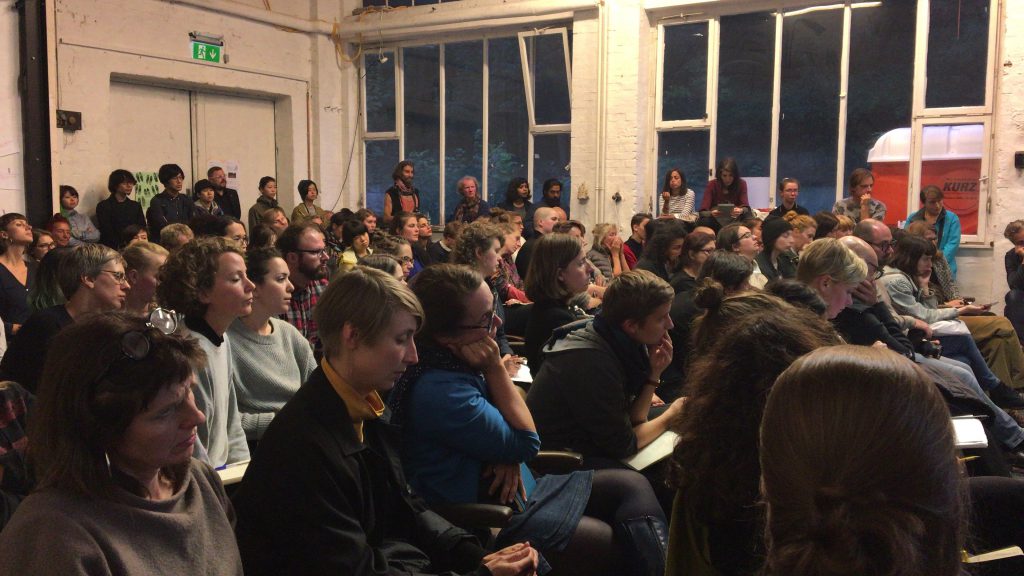
飛行機が遅れて予定より遅いドイツ到着となりましたが、このようなイベントの特質と目的についてディスカッションすることができました。翌日からの三日間は、限られた時間内で最大限見学するため、小人数のグループに分かれて異なる展示会場を見て回りました。
ドクメンタの最終日となる9月17日にカッセルを出発し、スロベニアのリュブリャナまで夜間移動しました。翌月曜日にはリュブリャナ大学で版画を教えるČrtomir Frelih教授と面会し、同大の版画研究室を訪問しました。その翌日はInternational Centre of Graphic Arts(MGLC) で開催されていた第32回リュブリャナ国際版画ビエンナーレBirth as Criterionを終日見学しました。ガイド付きツアーの後は、メインキュレーターBreda Skrjanecの案内で同センターが主催する大規模なレジデンスプログラムのために用意された版画工房などの施設を見学しました。MGLCの所蔵作品について紹介を受けて、現代版画美術館にも足を延ばし、book art (アートとしての本)の重要性の高まりについて話し合い、リュブリャナでの滞在を終えました。
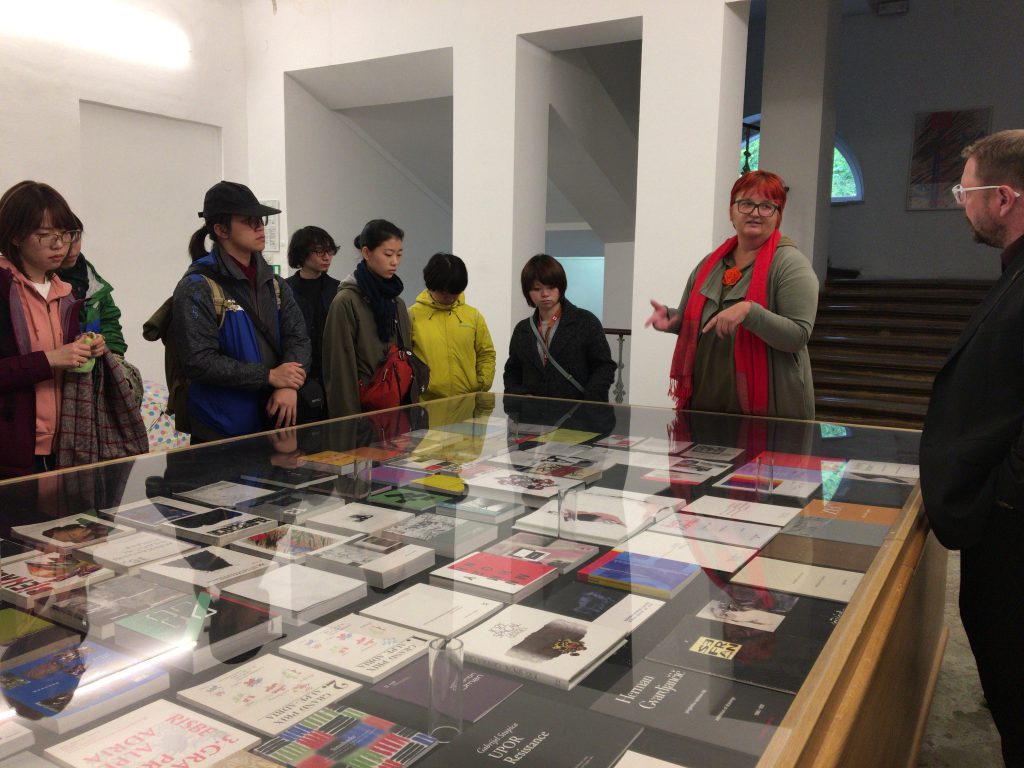
次の訪問地ヴェネツィアでの3日間は、ビエンナーレの主要企画展Viva Arte Vivaを始め、ジャルディーニ内のすべてのパビリオンや街中に点在する数多くの会場に足を運びました。再び小グループとなって分散し、限られた時間の中でひとつひとつをできるだけ見学することができました。
現代アートの代表的なイベントであるヴェネツィアビエンナーレの時期には、その膨大な数の観客を取り込もうと、独自に企画・公開される展示会もたくさん行われます。こうした機会を利用して、学生たちは大いに議論を呼んだDamian Hearst や David Hockneyの展示を見学したほか、Alexander Kluge、Thomas Demand、Anna Viebrock、Udo KittelmannによるThe boat is leaking, the captain liedのような新しいコンセプトについて調査することもできました。
ヴェネツィアでのハードなスケジュールを終えて向かったオーストリアのランデックでは、Gerald Nitscheによるアートギャラリー兼スタジオKarrnerwaldeleの招きを受けて、自分たちの作品を紹介しました。数多くの芸術作品に触れた後で自作をプレゼンテーションできたことは、重要な経験の一部となりました。新たな枠組みから自作について説明・再考し、自らの芸術的推進力に対する理解を深める機会となりました。
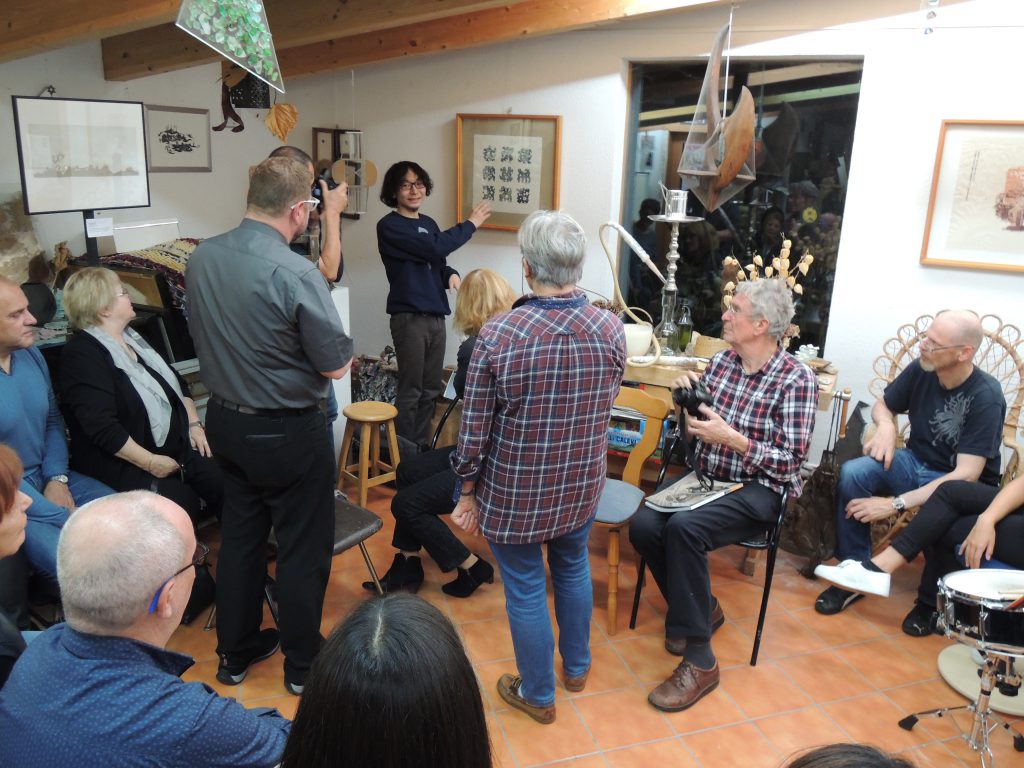
翌日は標高2020メートルの山頂で一日の始まりを迎えました。ものの見方に対する知的な変化が主だったこれまでの幾日とは異なる物理的な変化を山の上では楽しみ、これまでに見た展示会の体験やそれらの異なるコンセプト背景やキュレーション戦略、さらに芸術的表象行為や現在の視覚文化における顕著な傾向などについて議論しました。
グラフィックアートのビエンナーレや現代アートの主要なイベントをじかに見学できたことは、現代アートの発展と印刷メディアや版画との関係に対する理解を深める一助となりました。今回の研修旅行に参加した学生たちは、世界的なアートの言説のうちに自身の作品を理解できるようになりました。
日本へ帰る途中、ドイツのミュンヘン美術院を訪問しました。リトグラフ研究室を率いるGesa Puell教授に出迎えを受け、版画制作の施設や進行中のプロジェクト、スタジオ制作の流れなどについて話を聞きました。リトグラフの技術が誕生したまさに国でその道の専門家に会うことができ、さらに今後の交流について話し合うことができたのは、スタジオでの版画制作という経験の共有を介した近年の芸術的発展を理解するという試みの総仕上げとなりました。
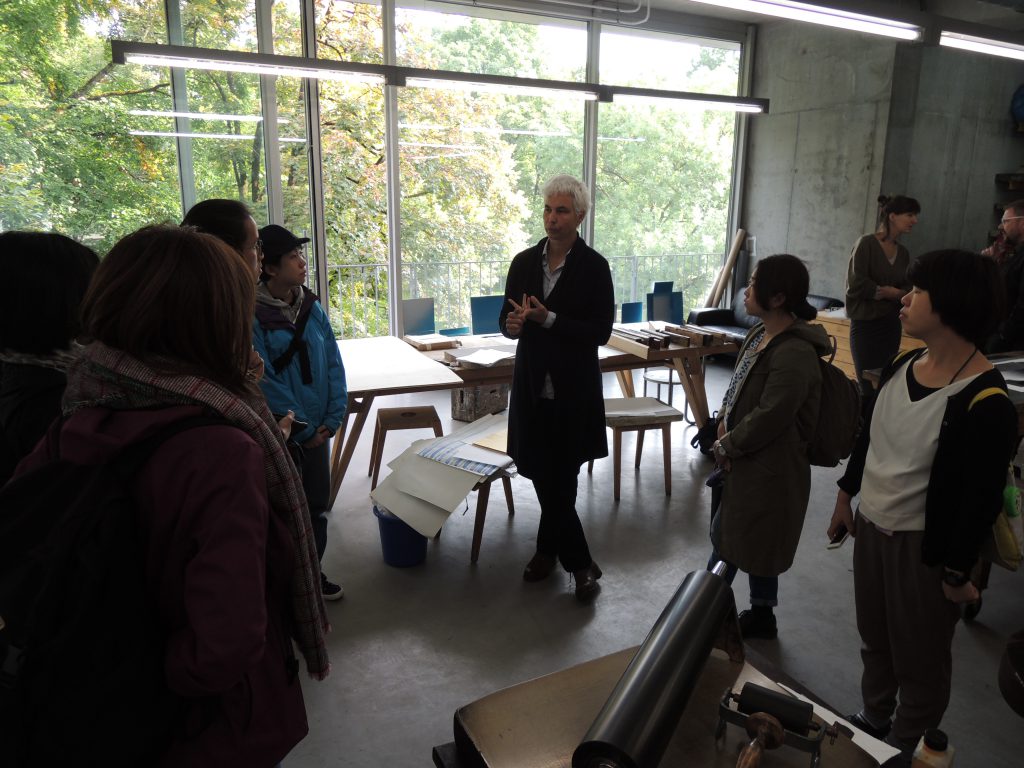
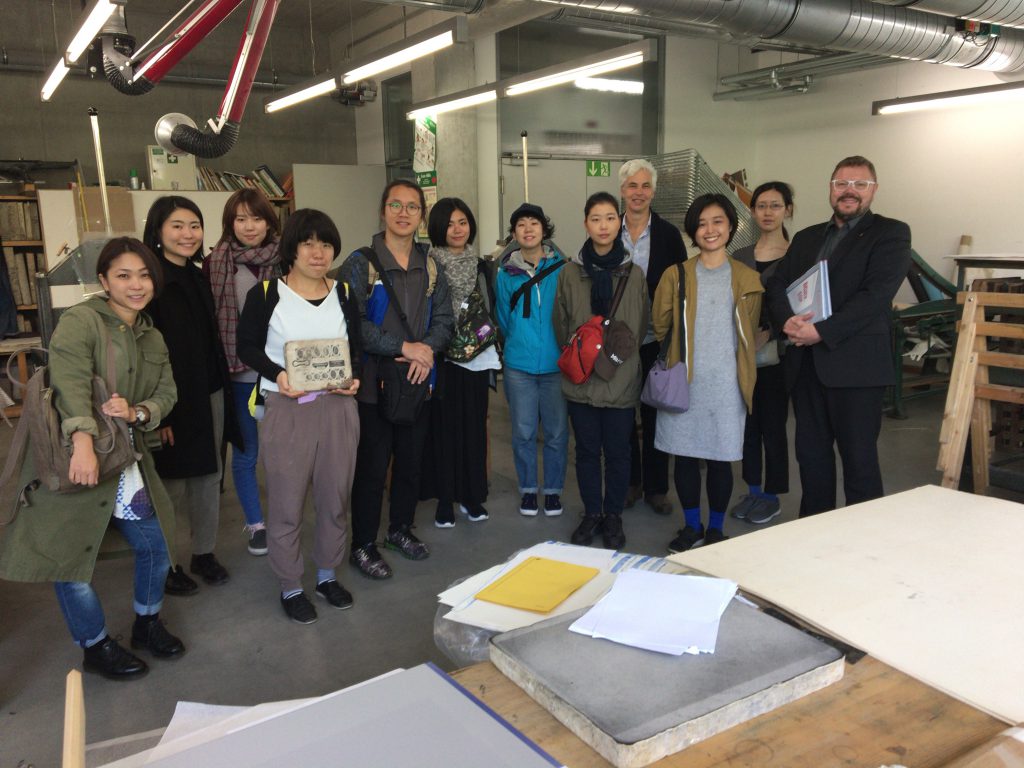
The trip to Europe in September undertaken by the students of the Printmaking Department of Geidai brought them to some of the major art events of the year. 2017 was offering the rare opportunity to see the documenta in Kassel and the biennale in Venice as well as the graphic art biennial in Ljubljana. In addition to them, the sculpture project in Münster (GER) that is held every ten years also happened at the same time. Even though the visit to Münster was not part of the official trip, some students took the opportunity to go there on their own.
The group first visited the documenta in Kassel. Arriving in the last week of this 100 day event allowed us to study the reactions to this show by critiques and artists and discuss the curatorial concept before arriving. We also were able to arrange for the participation in an event that was held within the educational project of the documenta: Knowledge gathering – Gathering knowledge, a Cooperation at Documenta 14 between School of Arts and Design Kassel, Bern University of the Arts, and Aalto University Helsinki.

Even though we arrived late due to the delay of the plane that brought the students to Germany, we were able to start the discussion about the nature and purpose of events like this. The next three days, students went to see the different venues of the exhibition in small groups in order to be fast enough to see as much as possible in the limited time of three days.
We left Kassel in the evening of September 17, the last day of the documenta and took over night transportation to Ljubljana. Arriving on Monday, we met with Prof. Črtomir Frelih, Professor of Printmaking at the University of Ljubljana and visited with him the printmaking studio. The next day was dedicated to the 32nd Biennial of Graphic Arts in Ljubljana: Birth as Criterion – Biennial of Graphic Arts Ljubljana at International Centre of Graphic Arts. We had a guided tour through the show and later met with the main curator Breda Skrjanec. Together we could visit the print studios and the places that the international center is preparing for an extensive artist in residence program. We finished the visit at the center with an introduction to the collection of the center (in the meanwhile also a museum of contemporary print) and a discussion of the growing importance of book art.

The next three days were spent in Venice where we visited the main show of the biennale „Viva Arte Viva”, all the pavilion in the Gardini as well as many other venues that are all over the city. Spreading out again in small groups allowed for an almost individual viewing experience and the opportunity to see as much as possible within the limited time.
The biennial in Venice,being a major event of contemporary art attracts independently produced and curated shows that utilize the incredible number of visitors. This allowed the students to see much discussed shows of Damian Hearst and David Hockney and to explore new concepts of exhibitions like the show “The boat is leaking, the captain lied” by Alexander Kluge, Thomas Demand, Anna Viebrock and Udo Kittelmann.
After an intensive time in Venice, we moved on to Austria where the students were invited to show their own work in the Gallery and Studio Space “Karrnerwaldele” of Gerald Nitsche in Landeck. Being able to present own work after the extensive intake of art was an important part of the experience as the need to explain and rethink the own production within the new context is offering the chance for a deeper understanding of the own artistic impetus.

The day after the opening was spent at a mountain top of 2020 meters, where we enjoyed the physical change of perspective in analogy to the intellectual change of perspective that has dominated the days before. Up the mountains, we met also to discuss the experience of the different major shows, the different conceptual background and curatorial strategies as well as the visible trends in the artistic representation and the current visual culture.
Having seen these major events of contemporary art and the biennial of graphic art firsthand helped the students to sharpen their understanding of the relation of print media and printmaking to the development of contemporary art. Students participating in “Europe Contemporary” are now enabled to understand their work as part of the international discourse on art.
On the way back to Japan, we had scheduled a visit to the Academy of Fine Art in Munich (GER). Prof. Gesa Puell, head of the Lithography studio was our host, introducing the whole group to the printmaking facilities, the ongoing projects and the structure of the studio work there. The opportunity to meet an expert of Lithography in the very country where the technique was invented and to be able to work on future ties with our colleagues there was the final step in an attempt to connect to the recent developments in art via the shared experience of the studio practice in printmaking.




